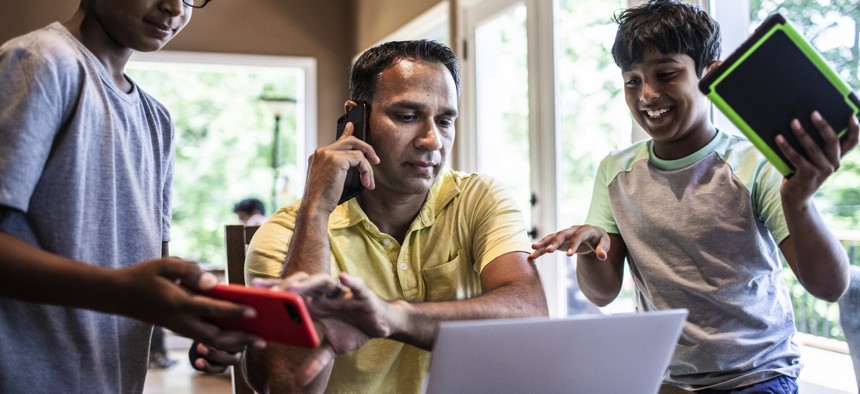How Much Are People Without High-Speed Internet Willing to Pay For It?

MoMo Productions via Getty Images
A new federal survey takes a look and finds that, for many who don’t have service because of the expense, the amount is $0.
In a first look at how low broadband prices would have to be to get more people online, those who say they do not have service at home because it's too expensive said in a federal survey that they are only willing to pay an average of $16 a month to get connected.
But even prices at that level might not be enough to close the gap with broadband affordability. Just over half–54%–of those who say they do not have broadband because of the cost, said they’d want it to be free, according to the survey, which the National Telecommunications and Information Administration released last week.
The survey, which sheds light on the 24 million households who lack home internet, was the first time NTIA, a branch of the Commerce Department, has asked people who do not have broadband how much they’re willing to pay to get online. NTIA began doing the annual surveys on internet use in 1994
“Our analysis shows affordability as a driving factor around why some households continue to remain offline, confirming that cost of service is an essential part of increasing Internet adoption,” the agency wrote in one of a series of blog posts about the survey.
The survey could provide insight for states as they go about developing plans for how to use the $42.5 billion included in the new federal infrastructure law to increase broadband service.
States are required in the law to offer a “low-cost” option for broadband service built with the money. Congress, however, did not define what would meet the requirement.
NTIA, in issuing a notice of funding opportunity in May, said it is requiring states seeking the money to create “a middle-class affordability plan to ensure that all consumers have access to affordable high-speed internet.”
However, the agency said it will be leaving it up to states to figure out what that would look like.
States, for instance, could require broadband companies receiving infrastructure dollars to offer low-cost, high-speed service. Or they could offer subsidies to customers to pay for internet service or use their regulatory authority to increase competition to drive down prices.
The lack of specifics has created a debate between consumer groups and the broadband industry that will continue to play out in statehouses around the country.
The amounts those surveyed said they’re willing to pay for internet service are far less than current prices for many Americans.
The Organisation for Economic Co-operation and Development estimates the average monthly bill in the U.S. is $61. NCTA – The Internet & Television Association, a trade group for the broadband industry, says American households are paying $46-a-month on average.
Consumer groups and the Biden administration have raised the idea of states requiring companies building broadband service under the infrastructure law to offer monthly plans for no more than $30.
That price – when combined with a $30 monthly Federal Communications Commission subsidy, called the Affordable Connectivity Program, would make getting online free for many lower-income people. Broadband companies, though, oppose such a requirement, saying it would be improper government rate setting. They argue that companies willing to offer the $30 monthly subsidy should be considered to be offering a low-cost service.
In agreements the Biden administration announced in May, 20 major broadband companies did agree to offer internet plans for $30 a month.
While not a mandate, NTIA also raised the idea of states requiring a $30 monthly plan, saying in its guidance that it is an example of what would be considered a low-cost option.
As in prior NTIA surveys, this latest one found that cost is not the main reason why more people do not have internet service at home. Rather, 58% of those who are not online said they do not have broadband because they don’t want it or do not need it.
In comparison, 18% said they are not online because of the cost.
Michelle Cao, an NTIA policy specialist and Rafi Goldberg, a senior policy advisor, for digital equity at the agency, noted in a separate blog post that cost could be a factor even for people who said they didn’t need or want home internet. Those who gave that reason tend to have lower incomes than those with service, they noted.
Just 15% of 108.5 million households that NTIA says have internet at home had incomes of $25,000 or less. But the survey results show that 35% of 13.8 million households who were not interested in having broadband service had incomes of $25,000 or less.
Meanwhile, 45% of 4.4 million who said they do not have service because of the cost, had incomes that low.
“Many households citing reasons other than expense may nevertheless still struggle with the cost of home Internet service and suitable devices in addition to challenges such as a lack of digital skills, barriers to accessibility, and other issues,” the NTIA analysts wrote.
In addition, the researchers noted that people who said they do not need or want internet service are willing to spend even less for broadband than those who cited cost.
On average, they said they were only willing to pay $6 each month. Eighty-three percent of those who do not want the service said they are not willing to pay anything.
Combined, those without broadband at home – whether it be because of the cost or that they did not want or need it – said they were willing to pay only a median of $ 10-a-month.
Kery Murakami is a senior reporter for Route Fifty.
NEXT STORY: CHIPS grants focus on seeding tech ecosystems






